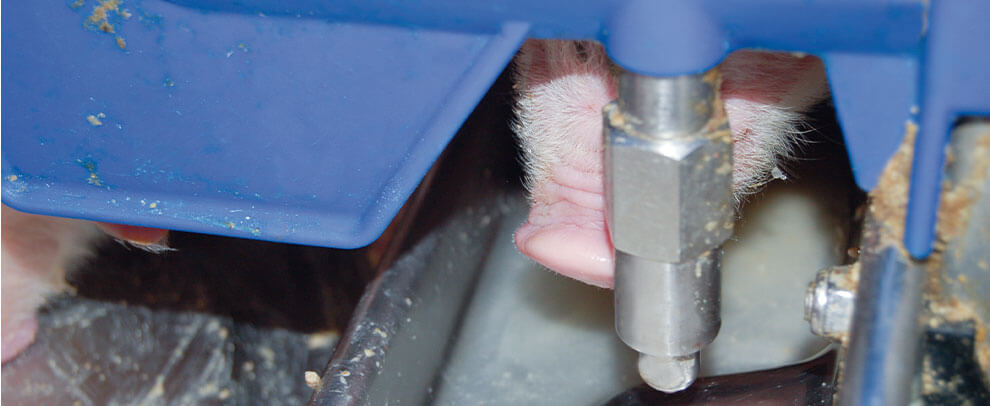Blog
Blog

Use of electrolyzed water as a sanitising agent in pig production
11th February 2020 - Studies
Xavier Puigvert Colomer. Doctor in Agricultural Engineering
Electrolysed water (EW) is a new antimicrobial agent that has been widely used for many years in Asia (mainly in Japan) and in Russia. In Europe and the United States, it is starting to become known, understood and applied in the livestock and agrifood sectors.
EW is water in a metastable state, formed by physical and chemical phenomena based on electrochemical activation technology. EW is generated when a dissolution of sodium chloride is subjected to an electrolysis process in an electrolytic cell. The result is the generation of two fractions of water, the water that comes from the anode (anolyte) and the water that comes from the cathode (catholyte). The result of the treatment is that certain properties of the aqueous solution - pH, redox potential (ORP) and structure of the molecules- are modified. The electrochemical properties of both fractions can be changed (pH, ORP, chlorine levels), modifying the intensity of the electric current, the speed and flow rate of the treated water and its route (time) inside the electrolytic cell.
The anolyte may have a pH between 3-7, an ORP of +400 to +1,200 mV and chlorine-free levels up to 1,000 ppm, and the catholyte, a pH between 10-12 and an ORP between -200 and -850 mV. Of the two fractions, the anolyte in its neutral form (pH 6-7) with a redox potential greater than 900 mV was the one most studied due to its disinfectant effect.
The effect of the ECA (electrochemical activation of water) solutions is temporary. After a certain length of time, the ECA products are deactivated and dissociated into the initial components (water and salt). That explains why ECA products must be generated on site, and why they are ecological and completely safe.
Below are the results of two applications of electrolysed water used recently in finishing farms.
1.- Sanitising effect of the drinking water
The sanitising procedure of the drinking water most often used in livestock farming is chlorination, which achieves acceptable asepsis at a very low cost. However, the use of chlorine as a water disinfectant poses certain problems that reduce its efficacy. Two of them are highlighted below:
- The chlorine loses part of its efficacy as a disinfectant if the water pH is higher than 7, because insufficient hypochlorous acid is formed.
- It does not eliminate biofilm; what is more, it may increase the problem due to the precipitations it causes. Biofilm is a physical, chemical and biological barrier that protects bacteria and other micro-organisms.
For this reason, the use of electrolysed water is proposed as an efficient and economical alternative. Many national and international regulations establish the minimum ORP values the water must have (in general, it is considered that disinfection is successful when the ORP is higher than +600 mV). The high sanitisation level of electrolysed water is mostly due to the perfect combination of these factors: ORP > 800 mV and more than 90 % of the chlorine in the form of hypochlorous acid.
In this test, the microbiological quality of the water in a finishing farm was analysed. The water was analysed at the tank exit and in a drinking trough at the end of the drinking installation. Although the tank exit values were correct, a recontamination of the water was observed in the pipes, with microbiological values that were not as acceptable at the end of the circuit, and without the presence of free residual chlorine. The presence of biofilm was detected in the water supply pipes. The drinking water was subsequently treated with 3 % EW.
After a test period of 30 days (during which most of the biofilm was gradually eliminated from the pipes), the microbiological results were totally favourable at the beginning and end of the pipes. It should be mentioned that residual free chlorine was still present at the end of the circuit, meaning that the water still had disinfectant potential.
2.- Reduction in salmonella levels during finishing
Over and beyond the results observed in the treatment of the drinking water, several studies also demonstrate that the intake of electrolysed water produces interesting effects on the physiology and health of the animals (improvements in intestinal problems and reduction in mortality, among others).
In this second test, performed in two different farms, the aim was to see whether the continuous administration of EW during finishing helped reduce salmonellosis levels in farms with high levels of infection. In the first test, the prevalence of salmonella in blood plasma during two periods of the finishing stage was studied (weeks 6 and 18). There was a reduction of over 40 % in the prevalence of salmonella in blood in the treated batch. A reduction was also observed in the number of deaths and a slight increase in weight in the treated animals.
In the second test, the presence of salmonella in blood plasma was analysed, as well as its presence in faeces. An analysis was made on live animals with a weight of 95 kg. The results confirmed reductions of 40 % in the presence of salmonella in blood plasma, and of 50 % in faeces.
In both cases, the water consumption of the pigs was monitored, with no decrease being observed in the consumption of the animals treated with EW.
The effects observed in sanitisation and in the control of salmonella levels show that the use of electrolysed water in pig production systems could be beneficial. For this reason, EW technology is a creative solution that deserves consideration and offers interesting possibilities for making livestock production methods compatible with environmental protection. More studies must be conducted in the future to establish optimal usage doses.
All these tests are part of a project financed by Operation 16.01.01 (Cooperation for innovation) with funds from the Catalonia 2014-2020 rural development programme.






